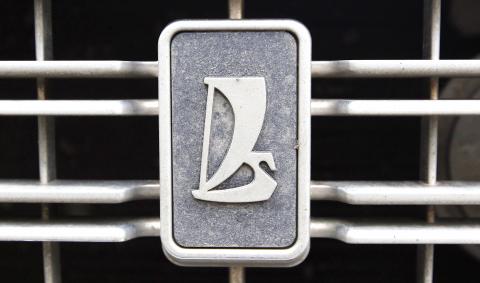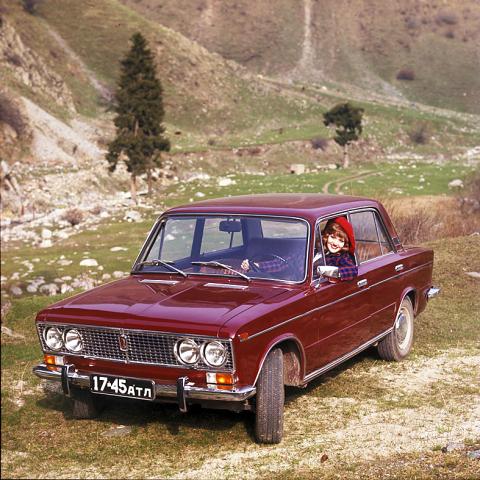Russia is ending its long love affair with a car that was once prized by the nation but has come to symbolize the decline of its automobile industry and, for some, the country itself.
The decision by state car maker AvtoVAZ to halt production of the last models in the Lada Classic series this year after four decades is more than just the end of the road for an automobile.
Although the outmoded box-like series of family cars is ridiculed abroad, many Russians consider it a last link with an era when they believed the Soviet Union could win the Cold War, and see its demise as a sign of Russia’s diminished status.

Photo: Reuters
“It’s a case of national affection. For many years in Soviet times the Classic was an unattainable dream for many men. It was very hard to get hold of one and people waited in queues for years,” said Vyacheslav Lysakov, a member of parliament and the head of a motorists’ association, Free Choice. “A lot of things from that [Soviet] time have already gone and the Classic was one of the remaining links.”
AvtoVAZ halted production last month of the seventh model in the series, the 2107, leaving only one Classic in production — the 2104 station wagon. The company said it was also “time to say goodbye” to that model at the end of this year.
Lada is often the butt of jokes abroad because of its square shape and reputation for breaking down when you least want it to. One joke asks: How do you double the value of a Lada? Answer: By filling the tank.

Photo: REUTERS
Jeremy Clarkson, host of the British TV car show Top Gear, memorably called the Lada 2107 “simply the worst car ever.” Style-conscious young Russians would not be seen dead in one.
But many middle-aged and elderly Russians regret the Classic’s passing and see bad omens for the future.
“It was the best-designed car in the world. You won’t see a more beautiful car,” Alexander Fyodorov, a 65-year-old architect, said as he strolled across Moscow’s Red Square.

Photo: REUTERS
“Russia has gone off course since then. The Russian auto industry has been destroyed. I blame it on 12 years of Putin,” he said, gesturing towards the red walls and golden domes of the Kremlin where Russia’s long-term ruler, Vladimir Putin, will start a new six-year term as president today.
Under a deal with Italian car company Fiat, the first Lada Classic 2101 was produced in 1970, based on the Fiat 124 four-door sedan that was popular across Europe.
The Classic, or “Zhiguli” as it is also known in the former Soviet Union, was a big hit in a country where car ownership itself was a status symbol and Western brands were not on sale.
Resourceful owners, used to shortages and shoddy quality of manufactured goods in the Soviet command economy, made do with what they had and soon learned how to fix the car themselves.
Its simplicity was a selling point, so was its ability to keep going in the severe cold. In later years, its low price and durability made it attractive, especially in Russia’s provinces.
“I love my car,” said Nikolai Dashkevich, a trained mechanic in Moscow who has a 25-year-old white Lada 2105, the fifth in the series. “More than half the parts are the original ones but it’s done more than 1 million kilometers.”
AvtoVAZ officials said the seven cars in the series had sold more than 17.75 million vehicles by March of this year.
But AvtoVAZ has struggled against foreign competition since the collapse of the Soviet Union in 1991. Side by side on the streets with hulking SUVs favoured by the nouveau riche, it became a symbol of the gap between rich and poor.
AvtoVAZ bowed to the inevitable last month by halting production of the 2107 after 30 years, even though the current starting price is low at US$7,000, provoking furious debate among car lovers in Russia.
“Let’s be reasonable and not dream of AvtoVAZ continuing to produce models without changing them for 30-40 years,” wrote a contributor to an online forum who gave his name only as Sony.
But many contributors disagreed. “AvtoVAZ has personally handed the market for budget cars to the Chinese auto industry, surrendered without a fight,” wrote one named only as Maxim.
Times are tough for Russian carmakers even though Frances’s Renault and Japan’s Nissan will take control of AvtoVAZ under a deal with state company Russian Technologies.
Lada sales fell 15 percent year-on-year in the last quarter and AvtoVAZ is recalling nearly 100,000 new Ladas because of technical faults, including 70,000 Lada Kalinas, a model Putin promoted by driving it 2,000km across Siberia in 2010.
Putin also tried to promote the new Lada Granta last year but took several attempts to start it when he test-drove it.
The decline in the national car industry is all the more galling for domestic producers as Russia is on track to become Europe’s biggest car market by the end of the decade, driven by rising incomes and a surge in consumer spending.
Car sales are expected to grow about 6 percent this year to 2.8 million vehicles and reach 4 million by 2015.
Renault, General Motors and Ford are among global players in the early stages of expanding sites or moving into those owned by Russian partners.
Many Russian experts are not optimistic for the future, saying Russian cars simply do not compete with foreign brands but some say increased competition will benefit consumers.
“Despite all the criticism of the authorities that you hear now, a new auto industry has been built on Russian soil, an industry which produces Ford, Volkswagen, Renault, Hyundai cars and so on,” said Alexander Pikulenko, auto industry commentator for Ekho Moskvy radio station. “The main thing is the consumer can get a good product that’s reliable, safe and cheap.”
Some Russians, however, are unlikely ever to be appeased.
“You see all these fancy foreign models in Russia now but we used to be proud to drive our own cars,” said Nikolai Peshkov, a businessman from Izhevsk, the city where the last 2107s were made in Russia. “I suppose there was no real choice then, but the Zhiguli was the real dream. If you had one, you had respect.”

On April 26, The Lancet published a letter from two doctors at Taichung-based China Medical University Hospital (CMUH) warning that “Taiwan’s Health Care System is on the Brink of Collapse.” The authors said that “Years of policy inaction and mismanagement of resources have led to the National Health Insurance system operating under unsustainable conditions.” The pushback was immediate. Errors in the paper were quickly identified and publicized, to discredit the authors (the hospital apologized). CNA reported that CMUH said the letter described Taiwan in 2021 as having 62 nurses per 10,000 people, when the correct number was 78 nurses per 10,000

May 5 to May 11 What started out as friction between Taiwanese students at Taichung First High School and a Japanese head cook escalated dramatically over the first two weeks of May 1927. It began on April 30 when the cook’s wife knew that lotus starch used in that night’s dinner had rat feces in it, but failed to inform staff until the meal was already prepared. The students believed that her silence was intentional, and filed a complaint. The school’s Japanese administrators sided with the cook’s family, dismissing the students as troublemakers and clamping down on their freedoms — with

As Donald Trump’s executive order in March led to the shuttering of Voice of America (VOA) — the global broadcaster whose roots date back to the fight against Nazi propaganda — he quickly attracted support from figures not used to aligning themselves with any US administration. Trump had ordered the US Agency for Global Media, the federal agency that funds VOA and other groups promoting independent journalism overseas, to be “eliminated to the maximum extent consistent with applicable law.” The decision suddenly halted programming in 49 languages to more than 425 million people. In Moscow, Margarita Simonyan, the hardline editor-in-chief of the

Six weeks before I embarked on a research mission in Kyoto, I was sitting alone at a bar counter in Melbourne. Next to me, a woman was bragging loudly to a friend: She, too, was heading to Kyoto, I quickly discerned. Except her trip was in four months. And she’d just pulled an all-nighter booking restaurant reservations. As I snooped on the conversation, I broke out in a sweat, panicking because I’d yet to secure a single table. Then I remembered: Eating well in Japan is absolutely not something to lose sleep over. It’s true that the best-known institutions book up faster